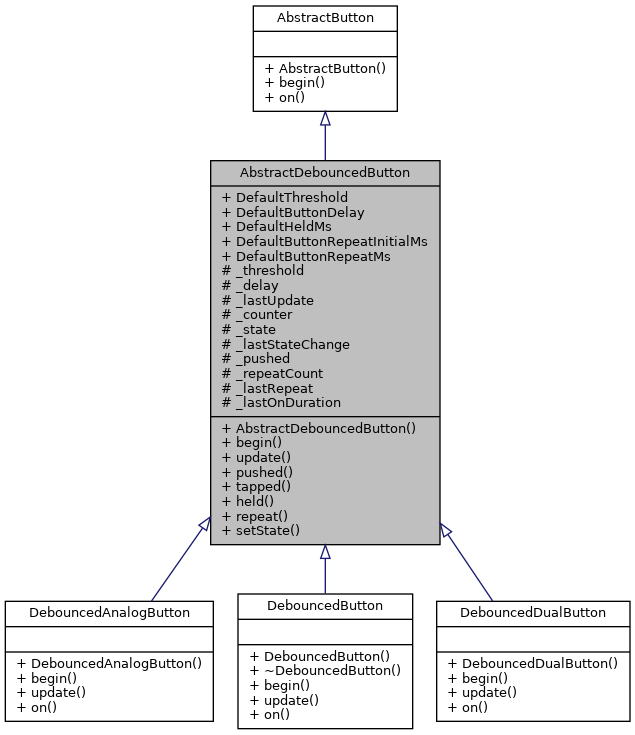#include <AbstractDebouncedButton.h>

Public Member Functions | |
| AbstractDebouncedButton () | |
| void | begin (uint8_t threshold=DefaultThreshold, uint8_t delay=DefaultButtonDelay) |
| virtual void | update ()=0 |
| bool | pushed (bool peek=false) |
| uint32_t | tapped (bool peek=false) |
| bool | held (uint16_t ms=DefaultHeldMs) |
| bool | repeat (uint16_t initialMs=DefaultButtonRepeatInitialMs, uint16_t repeatMs=DefaultButtonRepeatMs) |
| void | setState (bool newState) |
 Public Member Functions inherited from AbstractButton Public Member Functions inherited from AbstractButton | |
| AbstractButton () | |
| virtual void | begin () |
| virtual bool | on ()=0 |
Detailed Description
Timeslice-based button with debouncing.
AbstractDebouncedButton reduces / eliminates bouncing (multiple press events registing close together with only one physical press).
Definition at line 11 of file AbstractDebouncedButton.h.
Constructor & Destructor Documentation
◆ AbstractDebouncedButton()
| AbstractDebouncedButton::AbstractDebouncedButton | ( | ) |
Constructor.
Definition at line 6 of file AbstractDebouncedButton.cpp.
Member Function Documentation
◆ begin()
| void AbstractDebouncedButton::begin | ( | uint8_t | threshold = DefaultThreshold, |
| uint8_t | delay = DefaultButtonDelay |
||
| ) |
Initialization.
- Parameters
-
threshold how many tests of the pin must match for a state change. delay number of ms between tests of pin state.
Should be called from setup(), or at any rate, before other members are called. This will set the pinMode. The minimum time it takes for button presses / released to register is threshold * delay.
Definition at line 10 of file AbstractDebouncedButton.cpp.

◆ held()
| bool AbstractDebouncedButton::held | ( | uint16_t | ms = DefaultHeldMs | ) |
Test if held on for extended period.
- Parameters
-
ms time in ms the button has to have been on for to be considered held
- Returns
- true if the button is pushed and has been for longer than specified time.
Definition at line 34 of file AbstractDebouncedButton.cpp.


◆ pushed()
| bool AbstractDebouncedButton::pushed | ( | bool | peek = false | ) |
Test if the button has been pushed since the last time it was off.
This function returns true once, as soon as the button is pushed - even if it has not been released yet. If the peek parameter is false then subsequent calls to pushed will not return true until the button has been released and pushed again. The idea is to allow frequent tests in a tight loop, and only get one positive result (unlike on(), which returns true any time the button is depressed).
- Parameters
-
peek if true, do not reset the pushed state.
- Returns
- true if the button has been pushed and released since the last test.
Definition at line 20 of file AbstractDebouncedButton.cpp.

◆ repeat()
| bool AbstractDebouncedButton::repeat | ( | uint16_t | initialMs = DefaultButtonRepeatInitialMs, |
| uint16_t | repeatMs = DefaultButtonRepeatMs |
||
| ) |
Get periodic press results when button is held.
- Parameters
-
initialMs time between first press and first repeat in ms. repeatMs time between subsequent releats.
- Returns
- true when pushed every so often...
Definition at line 39 of file AbstractDebouncedButton.cpp.


◆ setState()
| void AbstractDebouncedButton::setState | ( | bool | newState | ) |
Explicitly set the state of the button.
- Parameters
-
newState the new state to have.
Definition at line 58 of file AbstractDebouncedButton.cpp.

◆ tapped()
| uint32_t AbstractDebouncedButton::tapped | ( | bool | peek = false | ) |
Test if the button has been pushed and released.
After returning a non-zero value (i.e. a tap was registered), the state will be reset. Only the last tap duration will be returned.
- Parameters
-
peek if true, do not reset the pushed state.
- Returns
- length of last tap in ms if the button has been tapped, else 0.
Definition at line 27 of file AbstractDebouncedButton.cpp.

◆ update()
|
pure virtual |
Allocate timeslice.
This method must be called frequently - usually from loop().
Implemented in DebouncedButton, DebouncedAnalogButton, and DebouncedDualButton.
The documentation for this class was generated from the following files:
 1.8.15
1.8.15